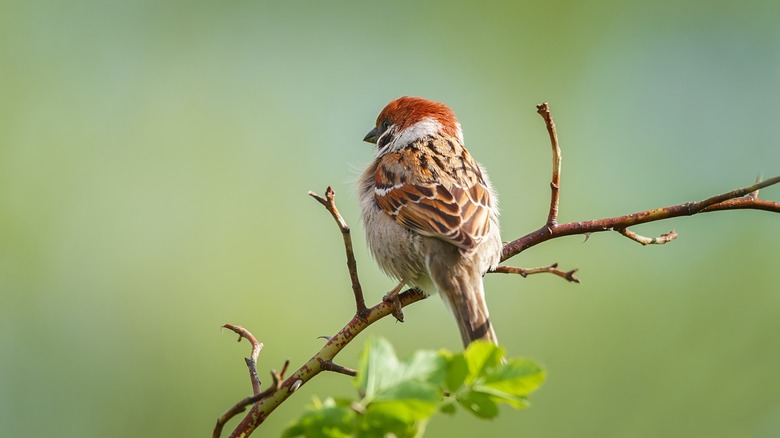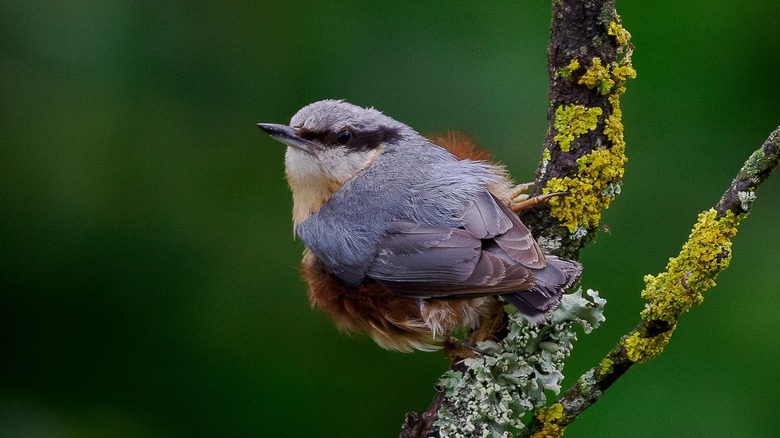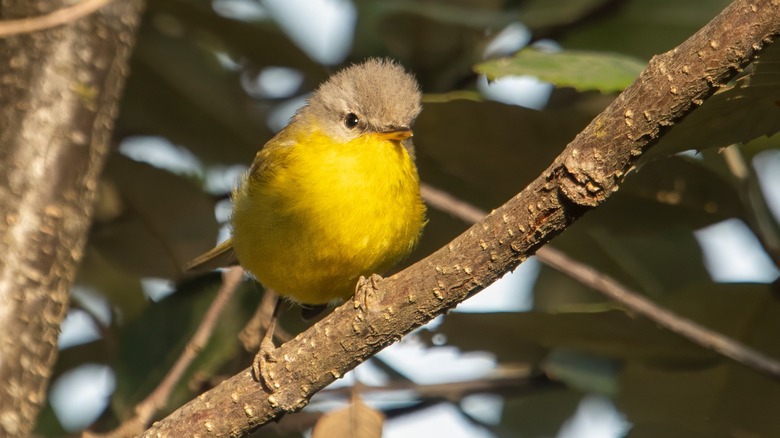11 Birds That Serve As Little Helpers In Your Garden
While there are some birds you don't want coming anywhere near your yard, there are plenty of others that serve a beneficial purpose. In fact, there are some birds that can almost be seen as little helpers in that they perform some of the more menial and aggravating gardening tasks that you'd rather avoid. What's even better is that they do a massive amount of work without you even realizing it.
Birds are worth so much more than simply filling your garden with their sweet songs. Depending on which types you are able to attract, they will help by controlling weeds and pests, and even aid in pollination. Just as there are plenty of insects that are beneficial to your garden, birds can serve an equally helpful purpose.
We're going to examine 11 small birds and let you know exactly how they help your garden. We'll also go over how to attract them, which serves to improve the overall ecosystem of your beautiful garden.
A sparrow's diet changes with the seasons
Kicking things off, we have sparrows. Now, house sparrows are not usually welcome in the garden owing to their aggressive and territorial behavior towards other birds. They're also known for leaving quite a bit of mess in their wake. However, in spite of these more negative traits, sparrows can be enormously beneficial when it comes to summer pest control.
In the fall and winter, sparrows will survive mainly on what seeds and berries they can scavenge from the ground. During the summer, however, they become nearly complete carnivores. Sparrows are big fans of beetles, spiders, caterpillars, greenflies, snails, slugs, and weevils. These insects are typically a detriment to vegetable and flower gardens, feasting on stems, foliage, and even fruit. Having sparrows around can help control these pests, but it does come at the cost of other birds being able to stake claim.
If you want to attract sparrows to your yard, you can bribe them with trays of sunflower seeds, ornamental grasses, and smaller trees and shrubs for nesting. Some native varieties, like the white-crowned or chipping sparrow, are going to be the most beneficial, as they tend to be less aggressive towards other birds than house sparrows.
Chickadees are small enough to get the tiny pests
The official state bird of Maine and Massachusetts, the black-capped chickadee has to be one of the cutest birds around. Thanks to its small size and beautiful plumage, chickadees are very easy to spot perched on tree branches or poking their heads out of small birdhouses. Don't think for a moment, however, that these tiny birds have a sweet disposition. While they are very accommodating of other birds, they are absolutely vicious as predators.
It's not uncommon to see a chickadee with some kind of insect trapped in its small beak. Thanks to their minuscule size, chickadees can go after many types of insects that some of the larger birds on this list won't even consider, such as aphids. These small, aggravating pests are a main cause of grief in most gardens, as they feast on stems and foliage, and spread viruses between plants. Thankfully, chickadees love them, and will pair them alongside other delicious morsels like slugs, insect eggs, and caterpillars.
Apart from insects, you would do well to leave out some extra seeds or suet cakes to attract more chickadees. A bird bath wouldn't hurt your chances either. Plus, if you have a perennial garden, chickadees will happily nibble on and spread seeds for you near the end of the season, ensuring that you'll have even more perennials the following spring.
Hummingbirds are expert pollinators
When we think of pollinators, we tend to think of insects like bees and butterflies. However, when it comes to birds, there is no better pollinator than the hummingbird. These small, quirky little birds may seem like insects at first. Their wings flap so fast that they make buzzing sounds, and they fly at such a speed that you can barely get a good look at them. But they are birds, and they love to draw on the sweet nectar of flowers and fruit blossoms.
When they are feasting on that nectar, the pollen from the flowers very easily gets caught up in their beaks and feathers. As a result, hummingbirds are able to easily transfer pollen between plants, fostering the cross-pollination that is so essential to a garden's health.
To attract these wonderful birds to your yard, you would do well to plant hardy perennials like bee balm, sage, hosta, catmint, flowering tobacco, and honeysuckle. You can also purchase hanging nectar feeders. As hummingbirds are territorial, hang these feeders apart from one another so you can invite multiple birds without one taking over the other. Plus, if you're fond of birdwatching, nectar feeders are a great way to get a longer look at these ridiculously fast birds. Avoid noise-makers like fountains or wind chimes, as hummingbirds don't like loud noises.
Nightingales fill your garden with song
If you're looking to make your garden a more musical place, you could go through the trouble of setting up a bluetooth speaker system to belt out your favorite tunes while you're tending to your plants. Or, you could go a more natural route and invite nightingales to your garden. Trust us, you should do the latter. Here's why.
Nightingales have the astonishing ability to produce 1,000 different sounds, creating an endless combination of calls that will sing through the breeze on a summer evening. This vocal diversity is the perfect natural soundtrack to your garden, and it comes with some added benefits. Nightingales also happen to be excellent hunters, feasting on pests like beetles, flies, hornworms, and countless larvae.
Nightingales prefer to nest in dense shrubs, thickets, and young woodlands. So, if you happen to have a particularly dense area in your yard, leave it alone. It will more than likely attract some solo male nightingale looking for a mate. You probably won't be able to see them, but you'll certainly be able to hear them.
Weed control courtesy of goldfinches
While all of the birds on this list can be considered a gardener's friend, goldfinches may hold the title of BFF. Though these small, bright yellow birds happen to prefer seeds to insects, don't let that put you off. Goldfinches happen to love eating the seeds of plants no one ever wants to see in their garden: weeds. And who wouldn't love more help when it comes to weeding the garden?
Goldfinches love to feast on the seeds of some of the most pervasive types of weeds that infest the garden. These include dandelions, thistle, and ragweed, all of which, when they take hold, have deep root systems that are very tricky to get rid of. So, while it may seem somewhat counter intuitive, leaving your weeds alone is actually going to serve as a net benefit to your lawn. The goldfinches will eat them, and prevent them from spreading further in the garden.
Goldfinches also love eating the seeds from perennials like coneflowers, zinnias, cosmos, and poppies. Having some feeders with other favorites like black oil sunflower seeds will also go a long way in fostering good will.
Colorful orioles love beetles
While it is wise to keep orioles away from your fruit-producing plants like cherries and blueberries, you don't want to ward them off from your yard completely. Smaller birds with deep orange and black plumage, orioles also happen to be experts at devouring insects. They are particularly fond of beetles.
Not all beetles can be lumped into the pest category, but there are certainly some that can do excessive amounts of damage to a flower patch and vegetable garden. Cabbage loppers, aphids, Japanese beetles, squash bugs, and asparagus beetles can wreak havoc on a garden. Certain homemade remedies, like a garlic spray, will help to keep them away, but orioles are excellent at utterly eliminating them from your garden.
If you plan on inviting some orioles in for pest control, make sure that your fruit plants are properly protected first. Then you could add some oriole nectar to your bird seed, or leave out halves of oranges to attract them. They love the sugars, which is one of the reasons they go after your berry bushes. However, as long as they are distracted by bugs and other feeders, you should have no problem with orioles in your garden.
Nuthatches are comical pest destroyers
You'd be hard pressed to find a more comical backyard bird than the nuthatch. Small and portly, they can often be seen excitedly skipping around and twittering madly at one another. Like their cousins, the black-capped chickadee, nuthatches do not look like predators. They are, however, experts at consuming insects.
It's thanks to their small size that nuthatches are able to get at some of the insects that larger birds miss. Like chickadees, they go for the smaller pests like aphids, ants, small beetles, moth eggs, wasps, spiders, and larvae. They will occasionally go after larger fare like grasshoppers, though they seem mostly content munching away on the small stuff.
It's very easy to attract nuthatches to your yard. You just need to offer them dessert in the form of large nuts like sunflowers and peanuts. They also love suet cakes, so having one or two of those for them to nibble on won't hurt, either. Consider it a thank you to these funny little tweeters for all the work they do at removing pests from your garden.
Mosquitoes don't stand a chance against swallows
If you've ever watched swallows dart through the air in loops and banking turns, you might think you're watching some sort of intricate mating ritual. What you may not know, however, is that these birds are not putting on any kind of performance for your or other swallows' sake. They are zooming around the air in attempts to devour mass quantities of the most reviled pest around: mosquitoes.
We challenge you to name a pest worse than mosquitoes. Ticks come as a close second for the dangerous diseases they carry, but we don't think anyone would disagree that mosquitoes are far more annoying. Thankfully, if you have some swallows around, you're not likely to be seeing many mosquitoes. This is because swallows are experts at eating these hated pests. In fact, according to Lake Tahoe News, a single cliff swallow can eat upwards of 1,000 mosquitoes every day. Multiply that by several swallows, and you could be looking at a mosquito-free summer. Wouldn't that be something?
The best way to attract these handsome birds is to build small nesting boxes that they can convert into their homes. If you have a compost pile, be sure to add extra calcium to it like egg shells as the swallows will search for those in order to lay eggs. If you have small berry shrubs, they also like those as a treat once they've had their fill of mosquitoes.
Warblers are colorful and love to eat insects
If you live on a heavily wooded lot with a thick canopy of deciduous trees, you may just have the perfect environment for warblers. These small, intensely colorful birds are highly common throughout the United States. They tend to nest at the base of shrubs, protected by the foliage and the higher canopy. They'll dart around the forest during the day, and even venture out into your garden where they will take care of some of the more elusive garden pests.
One thing warblers love to eat are grubs and caterpillars. Either insect is known to cause immense amounts of damage to both lawn and garden, so having warblers around to peck away at the ground and scoop up juicy grubs would be a very welcome sight. They also go after slugs, snails, beetles, and sawfly larvae.
Attracting warblers is easy if you have plenty of woods around you. If, however, you don't have that much forest nearby, consider providing offerings of dried berries, suet, and sunflower chips to get them to swing by. They'll return to the woods to rest, but if you can get them to your garden with bribes, you'll be better for it.
Enjoy the harmonizing tones of wood thrushes
With one of the prettiest and most easily identifiable songs in the bird world, the wood thrush is a small, brown speckled bird that you'd welcome to your garden for their harmonious tones alone. Hearing the call come over the wind is like hearing a lovely set of chimes gently clanging in the breeze. That said, there's more to the wood thrush than just its pretty voice.
Wood thrushes are excellent at devouring the types of insects that like to hide in your garden. The bird's natural eating habits include foraging under foliage for bugs such as ants, crickets, beetles, caterpillars, snails, moths, and aphids. Gardeners might not necessarily see all of these critters because they tend to hide on the underside of the leaf.
If you have berry bushes like elderberry, dogwood, or Virginia creeper, those will serve as automatic attractors for a wood thrush. If not, they do enjoy some black oil sunflower seeds and red or white millet. Set those up in a hanging feeder and wait to hear their sweet calls echoing through the air.
Owls provide nighttime pest control
When it comes to the bigger garden pests, like rats, mice, moles, voles, and other crawling critters, you're going to need something a little bigger than a thrush to help you out. Thankfully, owls will do the trick at taking care of any rodent pests you might have. They swoop in silently, attacking with fatality all those creatures that are eating your vegetables, ruining your lawn, or stealing eggs from your chicken coop.
It's actually very easy to make owls a part of your integrated pest management system. You simply need to construct some housing for the owls and they will make your property their home. Great species to attract are barn or barred owls, as they both have voracious appetites, and are not so aggressive that they ward off smaller birds. The best part is, owls are happy to partake in pest control while you're fast asleep.
Birds certainly do make a welcome addition to the yard, even if they are only for viewing. Now, however, hopefully you've seen how beneficial they can be in the garden, and will welcome them with open arms in the coming seasons.











